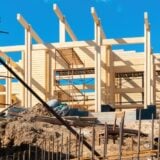Rates of annual falls across the prime rental markets in London have slowed but still declined by 1% in the third quarter of 2017, the latest analysis report shows.
Annual falls have slowed most noticeably in the most expensive markets in central London as demand and supply have become more aligned, particularly for super prime properties in the £4,000 plus per week sector.
The report from real estate firm Savills says that a key driver is the rising number of high net worth individuals choosing to rent rather than buy as a consequence of high stamp duty purchasing costs.
Although rents have been falling marginally for eight consecutive quarters, the prime rental market in London remains active, defying some of the economic uncertainty surrounding the UK’s decision to leave the European Union it explains.
A breakdown of the figures shows that the biggest quarterly fall was in North West London at 1.8% and rents are now 4.2% below a year ago at £41 per square foot, followed by a fall of 1.3% in West London quarter on quarter and 5.1% year on year to £28 per square foot.
Rents in central London are down 1% month on month to £37 per square foot and are 4.8% down year on year while in South West London they are down 0.8% and 45 to £26 and the North and East down 0.7% and 3.2% to £34.
The report explains that strong demand continues to come from needs based tenants who are particularly driven by the space and quality of accommodation they can get for their money, rather than limiting their search to a specific geographical area.
This is also true for corporate relocators who want to stretch what they can get with their allocated budget. As such, prime zone 2 to four locations such as Clapham and Richmond have become more attractive.
Less expensive properties in the market below £500 per week have witnessed smaller annual rental falls than more expensive properties. Likewise, smaller properties of one and two bedrooms have performed better than larger properties on both a quarterly and annual basis.
However, it also points out that this is not a recent trend. During the past five years, demand from affluent households, who either prefer to rent or are unable to raise a deposit to purchase, have supported rents.
Over this period, prime rents for one bedroom properties have held their own, displaying growth of 3.6%. By contrast, larger homes with six or more bedrooms, for which demand is much more discretionary, have seen falls of 13.6%.
Looking ahead, Savills expects that the prime rental market in London will continue to face headwinds. Although there are early signs that the amount of second hand rental stock coming to the market is easing, there still remains a significant supply imbalance which we expect will suppress rental growth over the short to medium term.
‘For landlords, pricing remains key. They must remain realistic to maintain demand for their property and prevent the risk of long void periods. With tenants increasingly widening their search areas to seek best value, landlords will need to make sure their property is of the best quality to attract demand,’ the report concludes.





